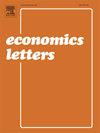How to select the number of factors in break point estimation of high-dimensional factor models?
IF 2.1
4区 经济学
Q2 ECONOMICS
引用次数: 0
Abstract
Predetermining the number of factors is required in break date estimation of high-dimensional factor models. In a model with () pre-break (post-break) factors, this paper shows the consistency of least squares (LS) break fraction estimator when the number of pre-break (post-break) factors is arbitrarily set to a value between () and the total number of pseudo factors minus one. Monte Carlo evidence suggests that break date estimation based on the number of pseudo factors enjoys higher accuracy than that based on the true numbers of pre- and post-break factors. This advantage becomes more obvious as the gap between and widens. Thus, break date estimation based on the number of pseudo factors remains a good choice when the numbers of pre- and post break factors are different.
如何在高维因子模型的断点估计中选择因子的个数?
在高维因子模型的断裂日期估计中,需要预先确定因子的数目。在具有ra (rb)预断(后断)因子的模型中,给出了当预断(后断)因子的个数任意设为ra (rb)与伪因子总数减1之间的值时,最小二乘(LS)断裂分数估计量的一致性。蒙特卡罗证据表明,基于伪因子数量的中断日期估计比基于中断前和中断后因子的真实数量的中断日期估计具有更高的准确性。随着ra和rb之间的差距扩大,这种优势变得更加明显。因此,当中断前和中断后因素的数量不同时,基于伪因素数量的中断日期估计仍然是一个很好的选择。
本文章由计算机程序翻译,如有差异,请以英文原文为准。
求助全文
约1分钟内获得全文
求助全文
来源期刊

Economics Letters
ECONOMICS-
CiteScore
3.20
自引率
5.00%
发文量
348
审稿时长
30 days
期刊介绍:
Many economists today are concerned by the proliferation of journals and the concomitant labyrinth of research to be conquered in order to reach the specific information they require. To combat this tendency, Economics Letters has been conceived and designed outside the realm of the traditional economics journal. As a Letters Journal, it consists of concise communications (letters) that provide a means of rapid and efficient dissemination of new results, models and methods in all fields of economic research.
 求助内容:
求助内容: 应助结果提醒方式:
应助结果提醒方式:


